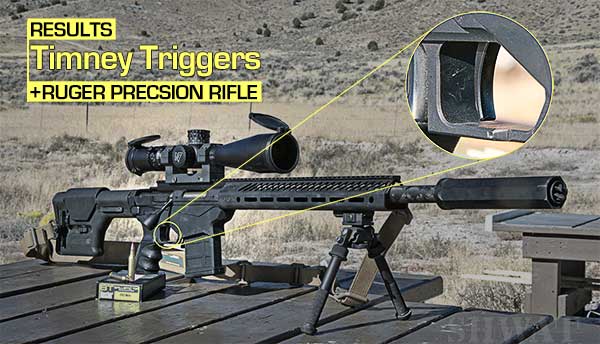
I was privileged to attend the first media event announcing the Ruger Precision Rifle. It was several months before the rifle’s public debut and I was skeptical until the first trigger press. The Ruger Precision Rifle impressed immediately. Not only did it shoot well, it was incredibly well thought out. In a sea of precision rifles requiring a second mortgage, Ruger made one that works at half the cost of my current scope.
Initial testing with the 6.5 Creedmoor was pretty astounding. Accuracy with factory ammunition hovered at half an inch or less over close to 1000 rounds. My hand loads occasionally reached into the .30 inch range. It was more accurate than many people will ever be able to shoot.
As it caught on and the haters stopped yapping and the aftermarket started to kick in, highlighting one of its strongest attributes. It’s no AR for user configuration, but is about as close as it gets with a bolt rifle.
Designed to accept AR15 hand guards, companies started catering specifically to the Ruger Precsion Rifle. Seekins Precision introduced a version of their proven SP3 rail that remains my favorite. It fits flush, is super strong yet light, and its flat bottom is perfect for precision rifle use. Any AR stock can be used and the barrel can be easily changed. Everything can be maintained or replaced with the use of simple tools, no lathe, mill, or machining needed. Companies immediately started making high quality precision barrels in several calibers, all easily fit with a barrel vise, AR multi tool, and head spacing gauges. Proof Research introduced a carbon wrapped barrel in 6.5 Creedmoor that added precision while removing weight and it just may be the perfect fit. My second Ruger Precsion Rifle started in .308 and has morphed into a tack driving machine after installing a Carbon Wrapped Proof Research 243 Winchester barrel. For most, that’s all you need, but for those accustomed to a more standard trigger feel it needed a trigger change, and Timney has stepped up to the plate big time.
Ruger Precsion Rifle Factory Trigger
The Ruger Precision Rifle comes from the factory with the Ruger Marksman trigger. I’ve shot thousands of rounds using that trigger and will say it is excellent in its own right. It fits most needs without a problem. Single stage, it uses a safety tongue of sorts prior to the first stage. Similar triggers from other manufactures have the same feel, the initial “take up” is a sort of trigger inside a trigger. When it reaches the main trigger it is ready to break. Given time, it feels like a two stage, but for some it’s just not comfortable. With a couple decades behind a conventional trigger, preferably flat and two stage, it just never felt right to me. Polymer pistols using a similar device have the same issues. As a long time 1911 carrier, it just feels odd, like it should not be there. My brain is conditioned to touch the flat trigger, take up stage one to the wall then press through if needed. I’m not alone, many have the same issues, meaning many have been clamoring for a more conventional precision rifle trigger for the Ruger Precsion Rifle.
Timney Ruger Precision Rifle Two Stage Trigger

As I was working through a number of tests on my Ruger Precsion Rifle, Timney Triggers was kind enough to send out a beta model for testing. Machined from bright red aluminum, it arrived in the usual Timney box. Removing the trigger reveals Timney’s typical attention to detail in machining. – it just looks really nice. Along with the trigger was a set of simple instructions for installation.
Like everything else on the Ruger Ruger Precsion Rifle, swapping out triggers is pretty simple. Set the rifle to safe, open the stock and remove the bolt. Using a 3/16 Allen wrench, with the stock folded remove the rear lower receiver take down screw, then the take down screw on the side of the lower. Turn the rifle over, lift and remove the lower receiver. At the front of the trigger is another 3/16 Allen bolt. Remove it, then follow the instructions on removing the factory trigger including the factory retention device and spring (it’s the trickiest part). Installation of the Timney is the reverse minus the retention device since Timney machines the locking ledges into the trigger body. Line up the rear ledges dropping the Timney trigger into the action, then push it forward lining up the bolt at the front of the trigger. Install and tighten the bolt and you are done. Reinstall the lower receiver and check to make sure the safety works. Timney sets the first stage at ½ a pound, and the second stage at 1 pound. You can adjust stage 1 to as much as a pound. Stage two is adjustable from ½ to 2 pounds.
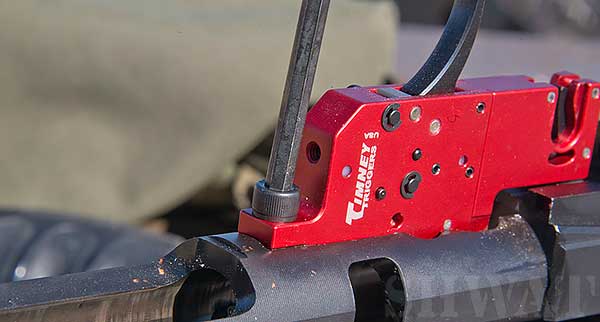
During dry fire practice it was pretty easy to find the wall, that place where stage one ends and you are ready to break stage two. Factory weights are a bit light for me, but during practice it seemed just fine. It was really easy to find the wall without unintentionally pressing all the way through. Much to my surprise, it just did not feel like a 1.5 pound trigger so I decided to give it a try on the range prior to making any changes.
Range Time
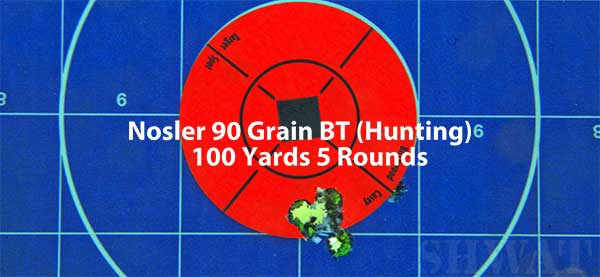
Proof Research had just provided a Carbon Wrapped .243 Win barrel to use for some upcoming tests of the barrel changing process. Having to rely on a gunsmith with a lathe to install barrels is a PITA, especially for me. Ruger uses a simple system utilizing an AR multi tool or something similar. It requires a set of head spacing gauges to install and insure proper and safe operation, but that’s about it. Even if you have a gunsmith perform the swap it takes about half an hour so no waiting months or outrageous bills.
Sighting is accomplished with a Nightforce 5-25 power ATACR scope with a MIL R reticle mounted in the First Focal Plane (FFP). The scope was mounted in a UMQDS 0 MOA rail from U.S. Optics. The hand guard is a Seekins Precision, the stock a Magpul PRS that was kindly donated by Brownells. Brownells also provided a few of the new 10 round AICS pattern magazines from Magpul. An older OSS BPR (Back Pressure Regulator) was used to control recoil and muzzle rise without the annoying blast from a brake. Accuracy during initial testing was impressive. Using Nosler 90 Grain Ballistic Tip it grouped under half an inch consistently. Using hand loaded Berger 105 Hybrids produced a couple .25 inch groups and a 6 inch group at 865 yards. After swapping the triggers it was time to see if accuracy was adversely effected.
Range Testing
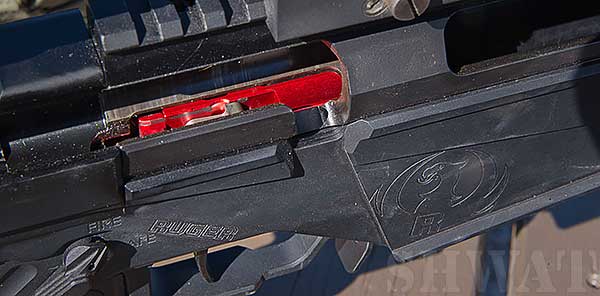
Since the Ruger chambered in .243 Win is well suited for hunting as well as competition, I used the factory Nosler first. At my elevation along with a hot summer it did almost 3100 FPS at the muzzle making it an excellent choice for game commensurate with the caliber. It is incredibly soft shooting and pretty “flat” dealing with wind nicely out to 600-800 yards.
Groups after the trigger installation were very close to my original zero. My worst group over 60 rounds was .56 inches. My best was closer to .40 inches. Clearly the trigger did nothing to hurt accuracy. What it did do was feel a ton better to me. Moving through to the second stage is very smooth, repeatable and consistent. The trigger is not flat but neither is it severely curved.
It may not be a bad idea to turn up the first stage a bit in extreme cold or when using heavy gloves. Testing using a set of heavy gloves it was still possible to exercise excellent trigger control. I never had a real issue but my big hands moved the trigger on occasion while getting into the guard.
My hand loads are pretty standard with 42.7 grains of H4350 in Nosler Brass using Winchester primers. Measured velocity using the 105 Bergers was 3010 fps. Loaded to work in either the AICS single feed or Larue Tactical SR25 magazines, it is quite a bit off the barrel’s lands, but it does not seem to matter. The Hybrids were consistently grouping around .4 MOA, but they really do well at range. It was very flat shooting at 500, 640, 864, and 1000 yards.

Trigger manipulation at long range is incredibly critical and the Timney Ruger Precision Rifle trigger excelled. Before the winds kicked up it was down right easy to hit center of steel at 500 and 640 yards. It took a better hold at 864 and 1000 yards, but it was doable. Once the winds hit 25 mph it was clear why my competition rifle is a 260 Remington. It was still possible to get on at 1000 yards with holds close to 3.0 mils, but it was much more challenging.
After flawless operation with more than 200 rounds was flawless I was pretty happy. It’s been back to the range several times and the Timney RPR trigger has never failed. No light primer strikes or failures to fire or stage. Since it’s a Beta version there are probably some issues, just none that showed up for me. It’s been in and out of the gun half a dozen times for photography and never fails when put back together. Not sure I can say that about many of the precision rifle triggers used.
Final Thoughts on the RPR and Timney
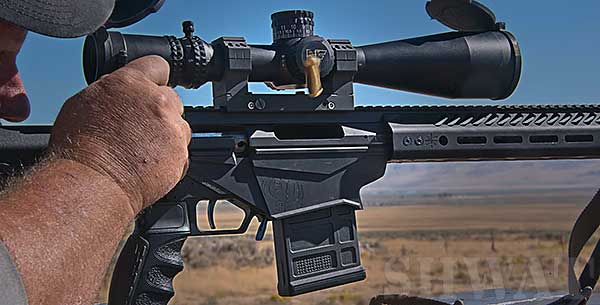
I have always enjoyed shooting the Ruger Precsion Rifle; my main complaint being weight. It is on the heavy side especially with a steel barrel. Proof Research’s carbon fiber barrel deals with that rather nicely, removing about a pound.
My other complaint was the trigger just took some getting used to. Not a big deal by any means, but it detracts a bit from my personal enjoyment. The addition of the Timney makes this rifle just about perfect for me. It matches the feel of the Timney two stage in my Surgeon Scalpel making transition seamless. Now my Ruger Precsion Rifle just might see a competition or two on shorter less windy matches and will certainly be used for training. A long range hog hunt might even be in order.
This trigger may not be a must have for many, especially if the Ruger Precsion Rifle is your first precision rifle. Their factory trigger is excellent and well suited to most uses. But if you are accustomed to the feel of a more traditional trigger, this Timney is your ticket. Excellent, reliable, consistent and repeatable – it has the same precision feel and operation you expect from Timney. Installation is simple and easy with no special tools needed. Retail is $219.95 and it is scheduled to be released later this month (September) but I am told it will be right there with most of their complete triggers. Either way, keep your eyes peeled and grab one while you can as my guess is these will go quickly. Precision rifles are all the rage these days with the Ruger Precsion Rifle a big part of the popularity. This trigger has been long awaited and looks to worth every bit of the wait.
Author Dave Bahde completed a storied career as a police officer. Today he is a full time gun writer, trainer at the legendary Gunsite Academy, hog hunter and friend of SHWAT™. Have a story to share?



I am going to perchase a trigger for my ruger in 308 it looks to be every thing that I have read also my buddy has one that’s why i’m checking them out + I have timney triggers on my other bolt gun of mine